
Olga Kromuszczyńska

okromuszczynska twarda.pan.pl
twarda.pan.pl
Research
topics
Gravitational deformation of mountains slopes on Mars and Earth
Profile
Education
2008 – 2010: Master (MSc) - Geology
> Adam Mickiewicz University in Poznań
> Faculty of Geographical and Geological Sciences
> Speciality: Stratigraphic and prospecting geology
> Thesis: Comparison of gneises from west and east part of Orlica-Snieznik Dome in the region of Międzylesie (Sudetes)
2005 – 2008: Bachelor (BA) - Geology
> Adam Mickiewicz University in Poznań
> Faculty of Geographical and Geological Sciences
> Specility: Mineral and water resources management
> Thesis: Geological conditions for planning and land use in municipality Santok
Research activities
Comparison between deep-seated gravitational spreading features on Mars and Earth
This comparison is investigated in Valles Marineris on Mars and the Tatra Mountains on Earth.Here is investigated the case of Coprates Chasma and the Ornak summit, in the Polish Tatra Mountains.
Uphill-facing normal faults scarps and crestal grabens, which are characteristic of deep-seated gravitational spreading (DSGS) of topographic ridges, are described in Coprates Chasma in Valles Marineris, Mars, and Ornak ridge and compared. The vertical offset of normal faults in the Martian instances varies from 40 to 1000 meters, with an average of 300 meters. The terrestrial faults offset is between few teens of centimeters up to 34 meters with an average of 10 meters. The values of horizontal displacement in Coprates Chasma vary from 10 to 680 meters, and at Ornak are in a range between 1 and 20 meters. Such difference corresponds with the difference of ridges scale and is due to the topographic gradient which is one order of magnitude higher on Mars than on Earth.
Deep-seated gravitational spreading (DSGS; known also as sackung [1, 2]) is a type of slow, large-scale slope deformation. The diagnostic features of DSGS deformation are crestal grabens and uphill-facing normal faults scarps. Such features have been identified on topographic ridges in Valles Marineris, the large trough system on Mars [3], as well as many terrestrial topographic ridges in orogens that were glaciated during the Quaternary [3]. The goal of this work is a comparison of geometry of the DSGS features identified on Mars and Earth. The studied here are in Coprates Chasma (Figure 1a) and a ridge south from Ornak, in the Polish Tatra Mountains (Figure 1b).
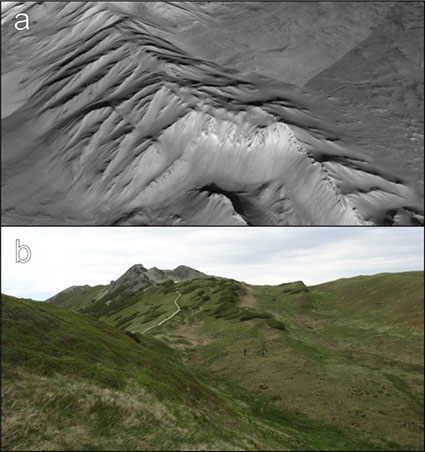
Figure 1: Topographic ridges affected by deep-seated gravitational spreading; a: Martian example, internal ridge in Coprates Chasma, Valles Marineris; b: terrestrial instance, Ornak ridge in Polish Tatra Mountains.
Data and methods
The
vertical
and horizontal displacement of the normal faults are
compared. These values are estimated from topography data
and corrected from scarp erosion and slope deposit
accumulation by assuming the fault dip angles to be 60-70º
(Figure 2), typical of normal faults in extensional
settings on Earth [e.g., 4].
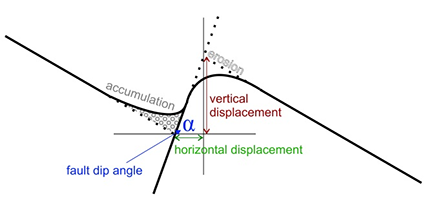
Figure 2: Parameters used for calculation of vertical and horizontal displacement.
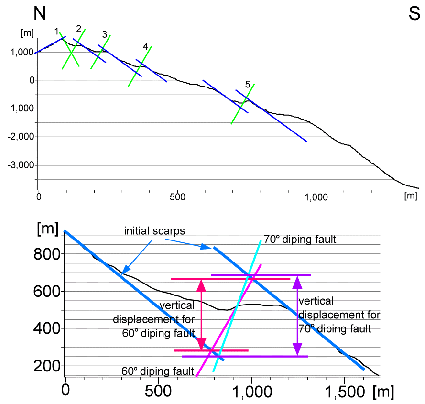
Figure 3: Example of calculation of vertical displacement (top: profile c1p5 in Table 1; bottom: fault #4 on profile c1p5).
Results
The results from Coprates Chasma were obtained along 11 profiles made on the north slope of the ridge based on Digital Elevation Models (Figure 4) with grid spacing of 30 meters and vertical accuracy of 15 meters [5]. During field studies in the High Tatras, 13 profiles across the Ornak ridge top were made using GPS device Garmin GPSmap 62s. The vertical accuracy of the GPS measurements has been analysed and the result of the analysis will be provided in the presentation.

Figure 4: CTX DEM of western Coprates Chasma draped over CTX image. Blue lines - profiles. North is to the bottom right.
Copates Chasma
The results (Fig. 5) show that the
vertical offsets of faults in the eastern part of the
investigated area are between 40 and 830 meters with an
average value of about 280 meters. In the west, the vertical
offsets are between 50 and 1000 meters. Average value in this
part is about 320 meters. Total downward displacement of the
ridge caused by sackung measured across the northern slope
only is 615 - 1420 meters in the east, and 710 - 1660 meters
in the west of the investigated area, which is consistent with
observation that the elevation of the horst summit decreases
from east to west.
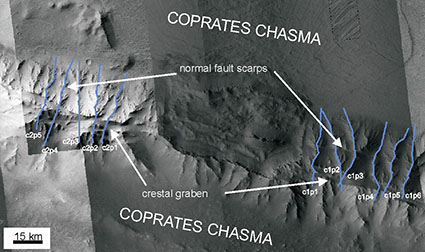
Figure 5: Sackung features affecting a horst in Coprates Chasma; blue lines: profiles used for analysis.
Ornak ridge
The field observations (Figure 6) showed that the smallest features related to DSGS on the Ornak ridge have a vertical displacement of a few tens of centimeters. The resolution of GPS profiles does not allow to recognize features with vertical displacement smaller than a few meters. The results of profile analysis shows that the vertical displacement of faults related to DSGS are from 2 to 34 meters. The average vertical displacement obtained from GPS profiles is 10 meters. The horizontal displacement is between 1 and 20 meters with an average value of ~5 meters.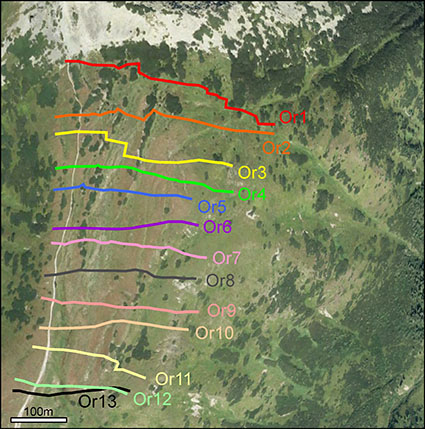
Figure 6: Profiles made on Ornak ridge, Tatra Mts.
Discussion
The vertical displacement of normal faults related to DSGS is significantly smaller at Ornak, 2-34 meters, than in Coprates Chasma, 40-1000 meters. The values of horizontal displacement at Ornak and Coprates Chasma are in the range 1 - 20 meters and 10 - 680 meters. At least one order of magnitude of difference in scale exists between the terrestrial and Martian DSGS features. The scaled value of displacements Dv and Dh, with
Dv = vertical displacement/height of the ridge
Dh
= horizontal displacement/width of the ridge
are
simliar for Earth and Mars: Dv=0,05; Dh=0,006 for Mars, and
Dv=0,02; Dh=0,004 for Earth. Therefore, the difference in
faults displacement scales with the difference in ridge dimensions.
References
[2] Varnes D.J. et al. (1989) Topographic and structural conditions in areas of gravitational spreading of ridges in the western United States, U.S. Geol.Surv.Prof.Pap., 1496.
[3] Mège D. and Bourgeois O. (2011) Equatorial glaciations on Mars revealed by gravitational collapse of Valles Marineris wallslopes, Earth Planet. Sci. Lett., 310, 182–191
[4] Gudmundsson, A. (1992) Formation and growth of normal faults at the divergent plate boundary in Iceland, Terra Nova, 4, 464-471.
[5] Kromuszczyńska O. et al. (2012) Giant Sackung Scarps in Valles Marineris, Lunar Planet. Sci. 43 (Abstract 1161).

